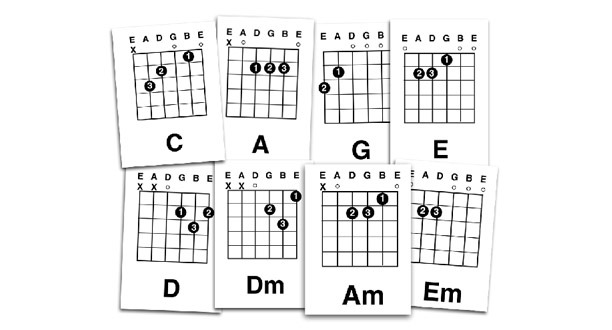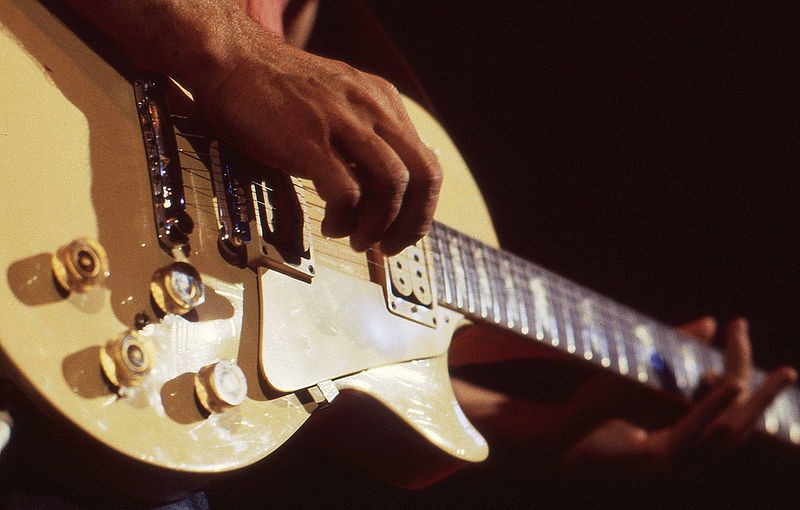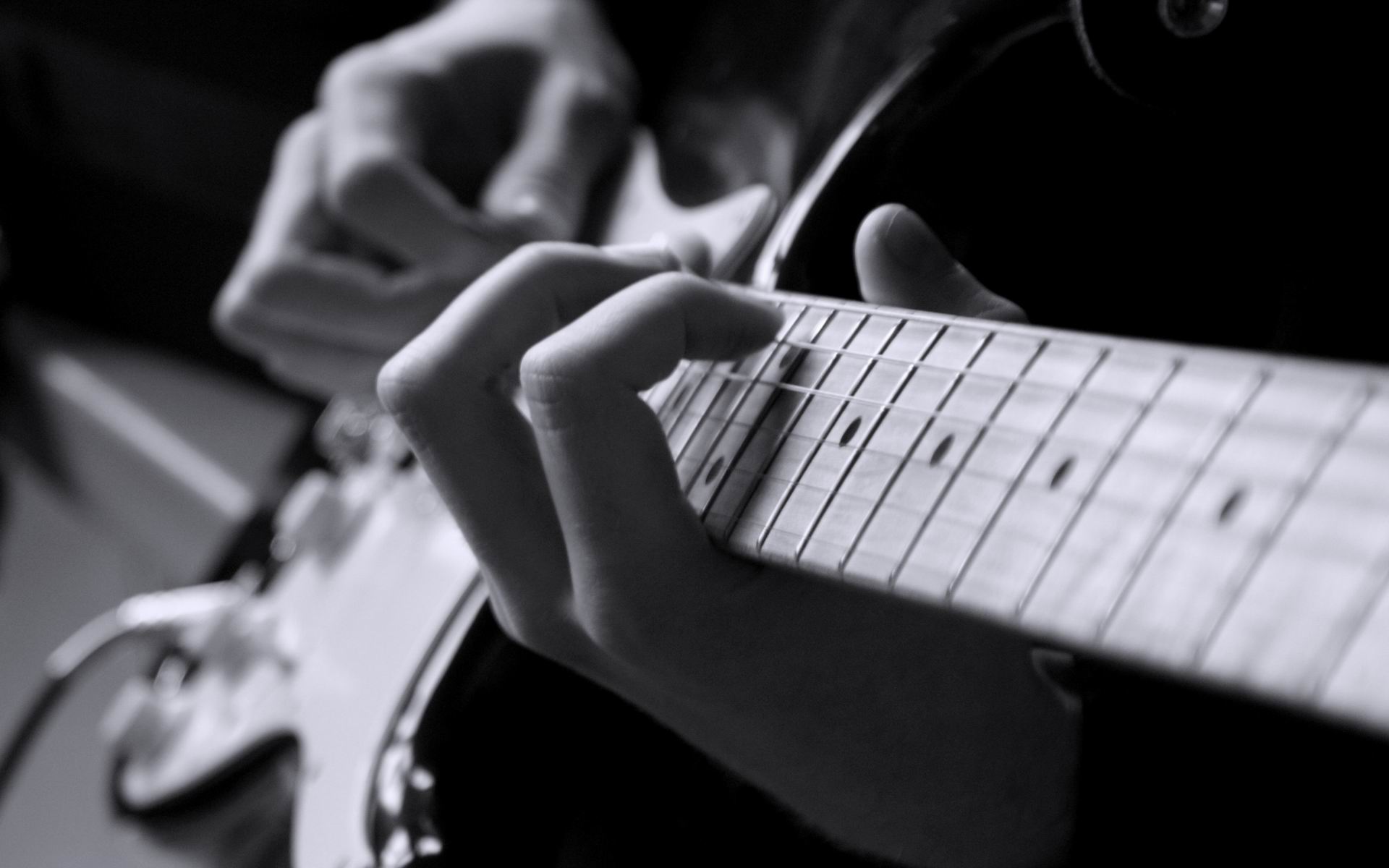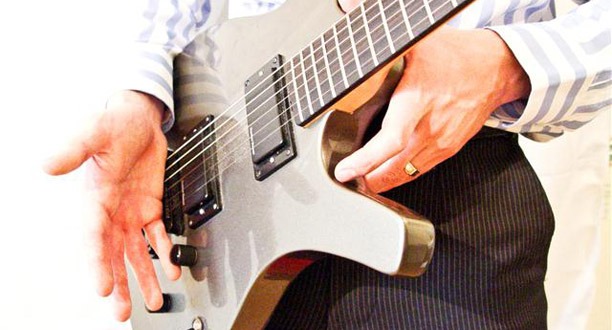Chords are the backbone of most guitar music. As a beginner, mastering the most common guitar chords allows you to play along to popular songs and even start writing your own. Technically speaking, a chord is a group of three or more notes played in one smooth strumming motion. Chords are classified according to the overall effect they produce. Major and minor chords, which create happy and sad sounds, respectively, are the most basic chords you’ll need to play beginner-friendly songs.
Understanding Chords
Getting to grips with how chords are formed gives you a basic introduction to music theory and helps you understand the ways you can alter them to create more interesting sounds. All chords are built from certain notes in scales. The C major scale is the easiest, because it just runs C, D, E, F, G, A and B. These notes are numbered (usually using Roman numerals) in that order, from one (I) to seven (VII).
A major chord is made from the I, III and V notes, so C major uses the notes C, E and G. To make a major chord into a minor, you flatten (lower the pitch by one fret, or a half-step) the III note. This means C minor is made up of C, Eb (flat) and G. So now, from the E major scale, E = I, F# (sharp) =II, G# = III, A = IV, B = V, C# = VI and D# = VII, you can work out both the major and minor chords. Sharps are just the opposite of flats, so you raise the pitch by one fret (or half-step). When you’re working out the E minor chord, you have to flatten the F#, which just makes it back into a natural (neither flat nor sharp) F.
Common Open Major and Minor Chords
“Open” chords get their name from the fact that they generally include strings played open. This means that the strings are played without being pushed down at a fret, which makes chords including them easier to play for beginners. When you start to learn chords, you have to focus on using the right fingers to press down each note and make sure you’re pressing the strings down firmly enough. Play each note of the chord one after another (known as playing an arpeggio) to check if any are being accidently muted or need pressing down harder. If you find that you’re accidently muting a string with one of your fingers, try lowering your thumb so the tip reaches around half way up the back of the guitar neck. This gives your fingers a better angle to approach the fretboard.
Here are the most common open chords. In the descriptions, the strings are referred to as the first string, second string, and so on. The first string is the high-pitched, thin one and the sixth is the thick one that’s closest to you when you’re playing.
- C major. Press your ring finger down on the third fret of the fifth string, your middle on the second fret of the fourth string and your index finger on the first fret of the second string. You strum every string apart from the sixth string.
- F major. This is fairly similar to the C, but a little more difficult to play. Press the fourth string down at the third fret with your ring finger, the third string down at the second fret with your middle finger, and the first and second strings down at the first fret with your index. You just flatten your index finger down across the two strings; lower your thumb if you struggle. You don’t play the fifth or sixth strings in this chord.
- G major. Push the sixth string down at the third fret with your middle finger, the first string down at the third fret with your ring finger and the fifth string at the second fret with your index finger. You play every string in this chord.
- A minor. This one is easy; fret a C major. Now move your ring finger onto the second fret of the third string. Play the same strings as you do in C major. Play C major and then A minor and note the difference in sound.
- E minor. Push down the fourth and fifth strings at the second fret. Use your index finger for the fifth string and your middle for the second. You strum every string in this chord. You can use your middle and ring fingers if you prefer.
Chord Changes
The hardest thing about playing chords when you get started is changing between them. To effectively change between chords, you need to be economical with your movements. Spend a bit of time thinking about where your fingers need to be for each chord, and work out the most efficient way to move from one to the other. For example, from a C major, you can flatten your index finger so it covers the first string too and move your middle and ring fingers both down a string to switch to an F. Easy changes to start with are between C major and A minor and G major and E minor.
Changing from C or F to G is pretty difficult, but you’ll get it with practice. If there’s just a small gap in your playing when you change between chords, you can normally get away continuing strumming anyway until your fingers catch up.
Putting Chords into Use
With just a little more music theory, you can learn to write simple songs with the chords you’ve just learned. The song would be in the key of C major (C, D, E, F, G, A and B). You can use the major chords for the I, IV and V notes and the minors for the II, III and VI notes. That means you can play a chord progression which uses all of the chords you’ve learnt, if you want to. Try one that starts with C, moves to F, then G and then back to C. This is the most basic progression, and uses the major chords you know. If you start with an A minor before going to C you can make a more interesting progression which incorporates both major and minor chords. Generally speaking, you want to focus on the chord with the same name as the key (the root), which in this case is C. Think of the other chords as either springing from it or leading back to it. Play around with the chords and see what you can come up with!












Guys it seems you have a mistake (misspelling) with forming an E Major chord on the last sentence of the 3rd paragraph in this article.
To play an E minor chord you don’t flatten F# (II), you flatten G# (III from E Major) so it becomes G natural.
Thanks.
I love how your chords look on your WEB site. I can cut and past them to help me learn songs quickly. However please add more chords I could not find several I was looking for.
Like Bmb9, AbMaj7.
I advise learning chord theory so you can play any chord. I have a complete free download that will teach you chord theory.